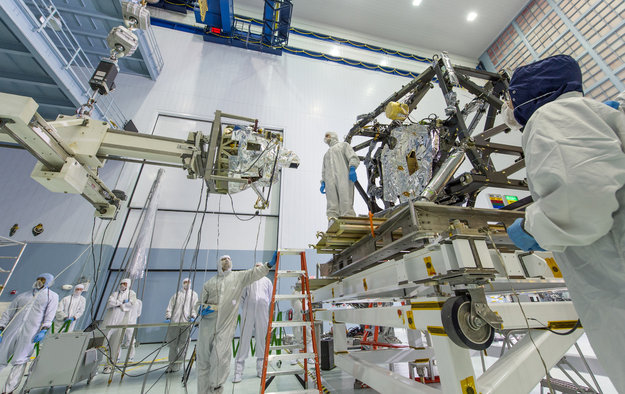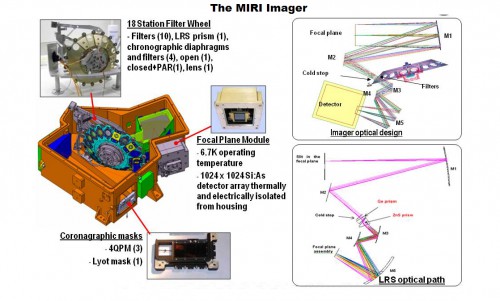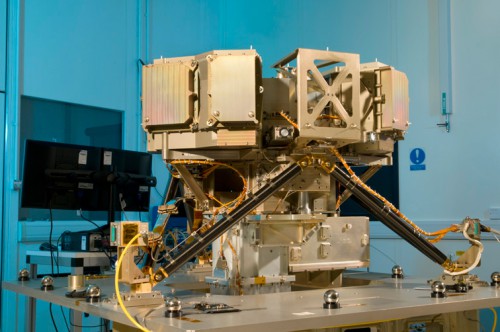
It was not too long ago that the last set of gold-coated Beryllium-made mirrors (18 in all) were delivered to NASA’s Goddard Spaceflight Center for installation onto the agency’s James Webb Space Telescope (JWST), and—although the mirrors are not installed onto the body of the telescope yet—work to install Webb’s four fragile science instruments began some time ago. Today, NASA released a time-lapse video of the installation of the telescope’s most sophisticated and technically challenging instrument: the Mid-Infrared Instrument (MIRI).
Workers in Goddard’s 1.3-million-cubic-foot clean room recently installed the state-of-the-art infrared instrument into a large component of the telescope known as the science instrument payload, or Integrated Science Instrument Module (ISIM), which acts like a chassis in a car to provide support and house all four of Webb’s science instruments. Integration of MIRI to ISIM, a process which requires a surgical installation for precision and accuracy, took four hours to complete, and the folks at Goddard made a time-lapse video of the install that was released to the public today (Feb. 20, 2014).
“Actual total time to install the MIRI was just over four hours,” said Jason Hylan, lead mechanical systems, mechanical integration and test, and opto-mechanical engineer for the ISIM at Goddard. “The MIRI had to be positioned to a tolerance of 25 microns, or one one-thousandth of an inch, which is less than the width of a human hair.”
VIDEO: Time-lapse of the install of the James Webb Space Telescope’s Mid-Infrared Instrument in a clean room at NASA’s Goddard Space Flight Center in Greenbelt, Md.
Once the JWST is in space and MIRI goes operational it will open up the cosmos to astronomers by giving them views of colder, more distant objects than has ever been seen before. MIRI’s camera and spectrograph will observe light with wavelengths in the mid-infrared range of the electromagnetic spectrum of five microns to 28 microns—longer wavelengths than a human eye can detect and even beyond the 0.6 micron to five micron wavelength range of Webb’s other three instruments.
“Using this mid-infrared instrument we will be able to view the Universe at unprecedented sensitivity, which will help us to solve the mysteries of galaxy birth as well as the formation of solar systems – a key to understanding our own origins,” said Professor Martin Ward, UK Science Co-Investigator on the MIRI project from the University of Arizona Department of Physics and Astronomy.

“MIRI presents great challenges but fantastic technological and scientific opportunities,” adds Dr Gillian Wright, European Consortium Principal Investigator for MIRI. “The sensitive spectroscopy provided by MIRI is especially important as it contains many unique spectral and diagnostic features that will enable us to study the properties and materials around forming stars in extreme detail. With MIRI onboard the JWST will continue the legacy of Hubble and become the world’s benchmark for imaging the wonders of deep space.”
MIRI’s camera will provide wide-field, broadband imaging that will undoubtedly continue to impress humanity with incredible views of the universe same as its predecessor, NASA’s Hubble Space Telescope. However, unlike Hubble’s cameras, MIRI will see objects 10 to 100 times fainter than Hubble’s cameras can see, and its spectrograph will enable medium-resolution spectroscopy, providing new physical details of the distant objects it will observe. Regions of obscured star formation, molecular hydrogen emission from previously unthinkable distances, the physics of protostars, and the sizes of Kuiper Belt objects and faint comets are all fair game to the power of the MIRI instrument.
Having the capability of both a spectrometer and an imager, basically being two instruments in one, gives MIRI the ability to point at an object in space to record both its image and spectrum. MIRI’s capabilities will also allow it to see light emitted by molecules that reveal a wealth of physical information and can reveal the presence of life on other planets, in addition to seeing through dust which obscures key phenomena such as star formation. Physical properties of objects across the universe, including temperature, mass, and chemical composition of those objects, will all be studied by the giant telescope thanks to MIRI, which will hopefully answer long-standing questions that Hubble and the other great observatories alone cannot answer themselves.
“The MIRI instrument and the Webb’s large telescope mirror will enable the highest resolution mid-infrared imagery ever achieved in space astronomy,” said Matt Greenhouse, project scientist for the Webb instrument payload at NASA’s Goddard Space Flight Center, Greenbelt, Md.

The instrument will need to be cold—very cold—in order to operate correctly. MIRI will operate at a temperature of minus 270 degrees Celsius, and it will take approximately 200 days after launch to reach its optimal operating temperature. To ensure MIRI is protected from excess heat, it is housed in a thermal shield, which basically resembles foil. To obtain images and spectra in infrared light that is invisible to the human eye, the JWST must be cooled to a very low temperature (-383 F or -230 C) in order to avoid being blinded by their own infrared emission, and, since MIRI will operate over longer infrared wavelengths than the other three instruments, it must be made approximately 35 degrees colder than the rest of the ISIM.
“MIRI will enable Webb to distinguish the oldest galaxies from more evolved objects that have undergone several cycles of star birth and death,” said Matt Greenhouse, ISIM project scientist at Goddard. “MIRI also will provide a unique window into the birth places of stars which are typically enshrouded by dust that shorter wavelength light cannot penetrate.”
Developed by a consortium of 10 European institutions in partnership with NASA’s Jet Propulsion Laboratory in Pasadena, Calif., MIRI’s mid-infrared coverage will complement the near-infrared capabilities of the other three science instruments on the JWST, including observations of the most distant objects to help determine whether or not they are among the first ones that formed in the universe.
Once complete, Webb—with its 69.5 ft x 46.5 ft instruments-protecting sunshield deployed—will be the size of a Boeing 737 airplane. Hubble, in comparison, is about the size of a large tractor-trailer truck or bus. Webb’s 6.5-meter-diameter primary mirror will also be bigger, much bigger. The telescope will have nearly seven times more light collecting area than Hubble, allowing for unprecedented infrared observations of distant objects from the dawn of the universe some 14 billion years ago.
A joint project between NASA, the European Space Agency (ESA), and the Canadian Space Agency (CSA), Webb will have been in planning, design, and development for over 20 years when it is launched atop an Ariane-5 rocket from Arianespace’s ELA-3 launch complex at the European Spaceport located near Kourou, French Guiana, in 2018.
Be sure to “Like” AmericaSpace on Facebook and follow us on Twitter: @AmericaSpace
.
Missions » James Webb Telescope »


